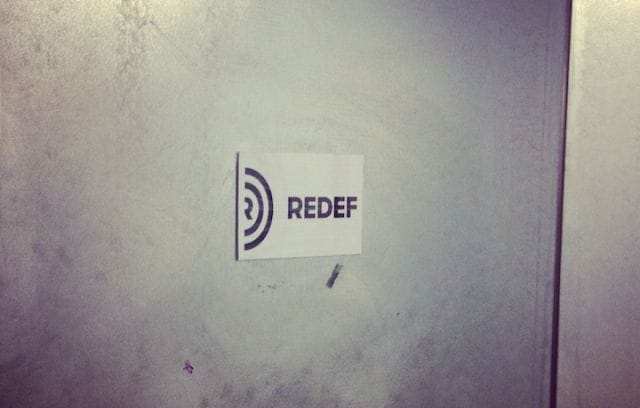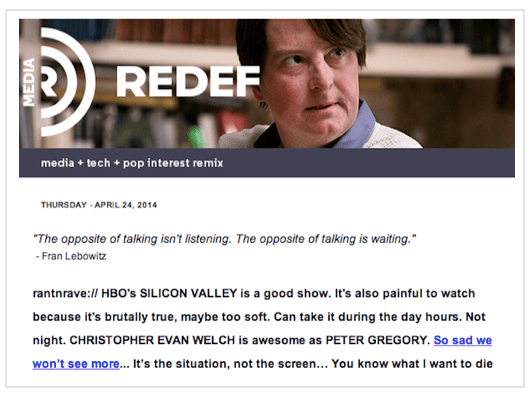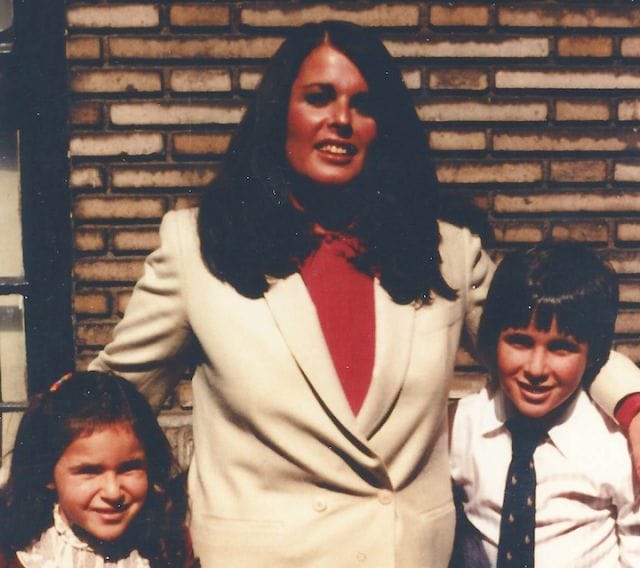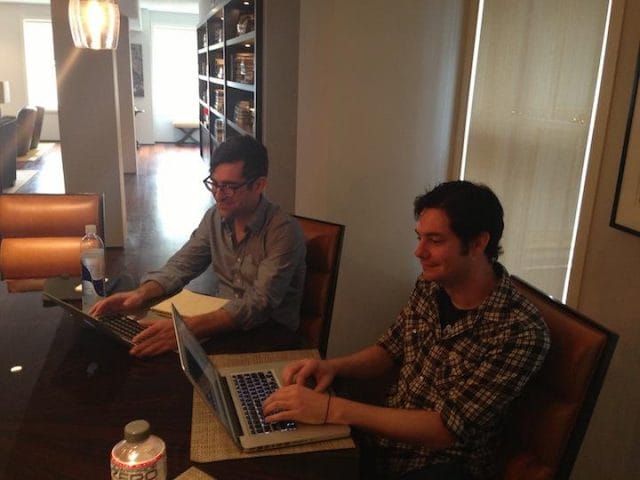
Almost every day for the last 2,714 days, Jason Hirschhorn has sent out MediaREDEF, his email newsletter of the day’s “must read” articles and assorted media. Jason missed a handful of days in the spring of 2012 when he suffered from severe double vision. Even still, he figured out that he could see well enough to send the email if he typed while lying sideways with an eye patch on. So that’s what Jason did, except for a few days when it was too painful and the email didn’t get sent.
Most remarkably, Jason balanced his obsessive media curation with the demands of fairly onerous full-time jobs. Until 2009, he was President of Sling Media, a startup that was acquired for $380 million by a satellite television company. Later, he was President of MySpace at a time when MySpace was still a big deal, though in rapid decline. Yet through all this, Jason always found time to send out a daily list of articles for people in the media and technology industries.

Jason (center)
In 2014, Jason decided to turn this hobby of clipping articles into a full-time job. He raised $2.2 million in angel investment from Bloomberg Beta and a host of investors including Jeffrey Katzenberg (CEO Dreamworks), Mark Cuban (owner of the Dallas Mavericks, extra on the show Entourage), and Bob Pittman (CEO Clear Channel).
His readers include Dick Costolo (CEO of Twitter), Barry Diller (IAC), and Katie Couric, as well as throngs of readers who want to stay informed about the happenings in media and tech. Perhaps most unique of all, many of the people who receive Jason’s emails absolutely rave about them. When’s the last time you felt that way about an email newsletter?
The Origin of MediaREDEF
In 1996, Jason Hirschhorn started a network of music websites in his apartment with names like RockOnTV, MusicNewswire, and ShowBizWire. Within a few years, traffic boomed. Sony Music got wind that the venture was run out of some guy’s apartment and smelled an opportunity for a good deal. Sony executives brought over a bunch of Playstations and “suggested” to Jason that they’d be interested in buying his company, but only if he didn’t talk to any other companies.
Instead, Jason contacted a lawyer to put his company in “play.” He received offers from several media companies, and he sold the company to Viacom in 2000. He was 28 years old and suddenly had his first real job. At Viacom, Jason rose through the ranks. By 2005, he was running digital media globally for MTV Networks.
Jason ran MTV Networks digital properties, which is to say he ran the part of the business that was a rounding error in revenue compared to the multi-billion dollar television business. As Jason tells us, “I thought of MTV as a digital property that had a bunch of TV channels that could promote the websites.” Everyone else at the company, however, thought of it the other way around.

Corporate headshot from the MTV-Viacom days
Since Jason was the “Internet Guy” at a non-Internet company, his opinion wasn’t always given due attention. So, instead of writing long-winded memos, Jason started forwarded articles to other MTV and Viacom executives that made his points. After a while, he got in the habit of sending a semi-regular digest of articles to a large list of people at the company.
Eventually, Jason started inviting people outside of Viacom to join the email list. First he added people he met at conferences or dinners around town. Eventually, readers forwarded his emails along to people like Rupert Murdoch and Barry Diller, and they became subscribers.
On November 25, 2006, Jason decided to formalize the newsletter and call it “MediaREDEF.” Why the name with strange capitalization? A nod to hip hop record label Def Jam records and how they pioneered remixed existing audio to make new songs. Jason’s goal was to remix the content of the web.
What is MediaREDEF?

The amount of content produced on the Internet everyday is seemingly infinite. Some of it is even good! Certainly more good writing, ideas, and videos are produced every day than a reasonable person could consume. But Jason is one of those unreasonable people who wants to go through it all and tell you what you should check out.
Jason sifts through thousands of RSS feeds every day to find the 20-30 things that are worth your attention. The topics range from media, to technology, to bits of popular culture. The content isn’t necessarily breaking news. Jason chooses articles that speak to larger trends of the media landscape, broadly-defined. On any given day, Jason could highlight articles that cover the legal battles of movie companies, to news economics, to a thought piece on Coachella.
We learned about MediaREDEF because Jason occasionally includes Priceonomics articles in the newsletter. It’s not that MediaREDEF necessarily sends a lot of traffic, but after our work is featured there, influential people in media outlets all of a sudden start featuring Priceonomics articles. That piqued our interest.
Take the example of our blog post “The Woman Behind Apple’s First Icons,” an interview with Susan Kare. Jason noticed the article from our RSS feed and posted it to MediaREDEF.
Legendary writer and chronicler of Silicon Valley Steven Levy then discovered the article and shared it on Twitter, noting that he found it through Media Redefined.
Steven Levy isn’t a celebrity per say, but he’s influential among journalists and Silicon Valley types. That led to The New York Times featuring the article, as well as a host of other sites like Dave Wiener’s Scripting News. Interesting people have shared other Priceonomics articles featured on MediaREDEF: Founder of Aol Steve Case shared our article on the history of slurpees, and NYU Journalism professor Jay Rosen shared a post about content economics. None of these people read Priceonomics regularly as far as we know, but they subscribe to Hirschhorn’s curated list of cultural tidbits.
Inclusion in MediaREDEF isn’t some traffic boondoggle like being on the front page of Reddit, but it lets you tap into an audience of influencers. Those people are hard to reach, but once one of them writes about you, others follow suit pretty fast.
Everything is a Remix, Including this Newsletter
“Rapper’s Delight” by The Sugarhill Gang is an influential piece of modern culture. As the above video points out, it was one of the first pieces of popular music to “remix” parts of an existing song. As a kid growing up in New York City in the 1980s, the song was especially memorable to Jason – his bus driver’s son was “Big Bank Hank”, a member of The Sugarhill Gang.
The first time he heard Rapper’s Delight, Jason immediately recognized the baseline from another song, “Good Times” by Chic (Chic noticed this too and brought legal action so they were properly credited). The notion that you could “remix” seemingly disparate bits of culture together into a derivative, but unique piece of work was a revelation to Jason.
Encouraged by his mother, Jason was a curious kid. She’d cut out articles for him, take him to museums, and let him soak up the different parts of New York. The impulse to curate and put together pieces of culture was set from an early age.
My mother has always been a significant influence on my life. I basically grew up in a one parent household like many other kids.
Ever since I can remember, my mother spoke to my sister and I with respect and encouraged us. She loved music, movies, television, was a voracious reader (books), theater, etc. That joy rubbed off on us. She always asked us to ask how, why and what if we didn’t understand something.

Jason, his mother, and sister Jody.
Today, Jason thinks of himself and his curation platform as a DJ who is “spinning” together various pieces of content he finds on the internet and broadcasting it to the subscribers of MediaREDEF. As Jason puts, “The internet never runs out of fish. I can pick from anywhere.”
On any given day, The New York Times, The Atlantic, The Economist, and even the lowly Priceonomics Blog publish lots of articles that are either directly or tangentially related to media and technology. Jason reads through it all, “remixes” it together, and sends out the compilation as a daily email or via the Twitter feed.
Anyone can subscribe to Jason’s email list, but it just so happens that fairly busy and influential people make it part of their daily routine. So how did billionaires and media titans become fans? MediaREDEF investor Jeffrey Katzenberg tells us that Jason is “one of the all-time great networkers.” Another investor, Mark Cuban, tells us he met Jason through an annual dinner Jason throws. How did Jason build up this network of readers and contacts? Well, he’s worked at at some pretty interesting places over the last decade.
You Don’t Get to Be President of MySpace Without Making a Few Friends
In 2005, while still working at MTV, Jason attended the Consumer Electronics Show (CES). There, Jason met an entrepreneur named Blake Krikorian who demoed a new kind of consumer device called the Slingbox. You plugged it into your cable box and like magic, you could watch cable TV channels over the Internet. To Jason, a television enthusiast who accumulated a massive backlog of shows to watch whenever he traveled, it was an idea whose time had come.
Jason left MTV Networks and joined Sling Media in 2006 as President of Sling Entertainment. At the time, every single cable and media company was trying to kill them off. Jason found the prospect of fighting an “unfair fight” too intriguing to pass up.
Media companies didn’t know how exactly the Slingbox worked, but they knew they hated it. But as with the Aereo television service today, they assumed it would unleash pirated content or disintermediate cable companies. They viewed Slingbox as the Napster of the TV and movie industry, mostly because that’s how the media portrayed the startup.
To better influence the industry narrative about the company, Jason and Blake drew up a list of 800 people in the television media industry and sent them all Slingboxes. Each package contained a special phone number that directed a Geek Squad technician to install a Slingbox in their homes. When Jason next met with these people, he got a much warmer reception because they had tried Slingbox and enjoyed watching TV from their laptops when on the road.
In 2007, Sling Media was acquired by the satellite television company Echostar for $380 million in cash. After a yearlong stint at the company, Jason left to take some time off and travel. He moved to Miami to enjoy the weather and relax in early 2009. Almost immediately, he got a call from Rupert Murdoch asking to meet and talk about MySpace.
Jason met with Murdoch for about an hour and half and discussed MySpace. It wasn’t clear whether the conversation was a job interview, but if it were a job interview, Jason wasn’t sure he wanted the job. MySpace in 2009 was still very massive in terms of unique visitors, but it was obvious that Facebook had stolen its thunder.
A month later, he received a call from Murdoch and his team offering him the job of Co-President and Chief Product Officer. Jason decided to take the job. In retrospect, Jason remarks he probably should have spent more time doing due diligence on the state of MySpace and its user engagement. But in 2009, Rupert Murdoch making you an offer to help run one of the largest companies on the web was too good to pass up.
Working at MySpace in 2009 was, according to Jason, was “like the opening scene of Saving Private Ryan every day.” For those unfamiliar, the opening scene involved soldiers storming the beach at Normandy in WWII and instantly being gunned down by the enemy. Jason tells us that News Corp gave them all the resources they needed in order to turn around MySpace, but he just couldn’t do it. MySpace continued to crater and by 2010 Jason left the company.
Launching REDEF, the Company

REDEF team members.
In 2010, after leaving MySpace, Jason spent three years traveling, thinking, and also sending out his daily email. But in 2013, he received some bad news that made him reconsider his career: his mom was diagnosed with terminal cancer and had only a year left to live.
Jason’s hobby of assembling pieces of content to share with his friends and contacts was in many ways a testament to his mother’s practice of clipping articles for him when he was a kid. Jason wanted to turn his passion of curating the most interesting articles on the web into a business and do so while his mother was still alive.
A lot of the time I spent with her in the last year of her life was not only talking about the past, but also sharing the love we both had for learning and specifically the arts. We saw movies each week we were together, we discussed shows, etc. It’s hard to even talk about since the sadness is still new. But when I enjoy an article, or a film or a tv show or song, it’s very tough that I share these appreciations for a living now, but I can no longer share them with the most important person, the one that gave me the spark.
And thus, the company, its ethic, its reason for being, is a tribute to her and how she shaped me.
And so, in 2014, almost eight years after he started building this list of subscribers, Jason raised a round of angel funding and launched MediaREDEF as a business, called REDEF. With a small team in place, REDEF now has a website and is building a mobile app to accompany its email and Twitter feed.
It’s also expanding into multiple channels in addition to media. MediaREDEF continues as the signature channel catering to media and technology. They’ve now launched a channel for the Fashion industry (FashionREDEF) and have plans for several more REDEF channels. The eventual goal is for industry executives to find the information so valuable that they’ll gladly pay for a subscription.
Competition in the curation/aggregation space is fierce. Apps like Flipboard, Prismatic, and Digg curate interesting content for free. Graham Holdings, owner of Slate (and former owner of The Washington Post), recently launched an aggregation app Trove, and stated that Hirschhorn was the their influence:
“We’re trying to enable Jason’s platform but more widely. Making Jason Hirschhorn scale, picking [the] best stories, contextualizing why it makes sense and sending it out to people who really care about the subject.”
Of course, Jason is trying to enable his platform more widely too. REDEF is hiring more curators, building its technology to find and disseminate content, and finding new ways to grow. REDEF is no longer a one man show. But even as the company grows, Jason will likely still be the secret sauce. He’s built a network of readers that care what he has to say over a very long time.
More importantly, Jason really loves curating articles that he thinks you should read. He loves it so much he’ll wear an eye patch and type lying sideways if that’s what it takes to put together the daily digest. He did it for eight years as a hobby, just because he likes it. That kind of passion is very hard to replicate.
This post was written by Rohin Dhar. Follow him on Twitter or Google Plus. To get occasional notifications when we write blog posts, sign up for our email list.



